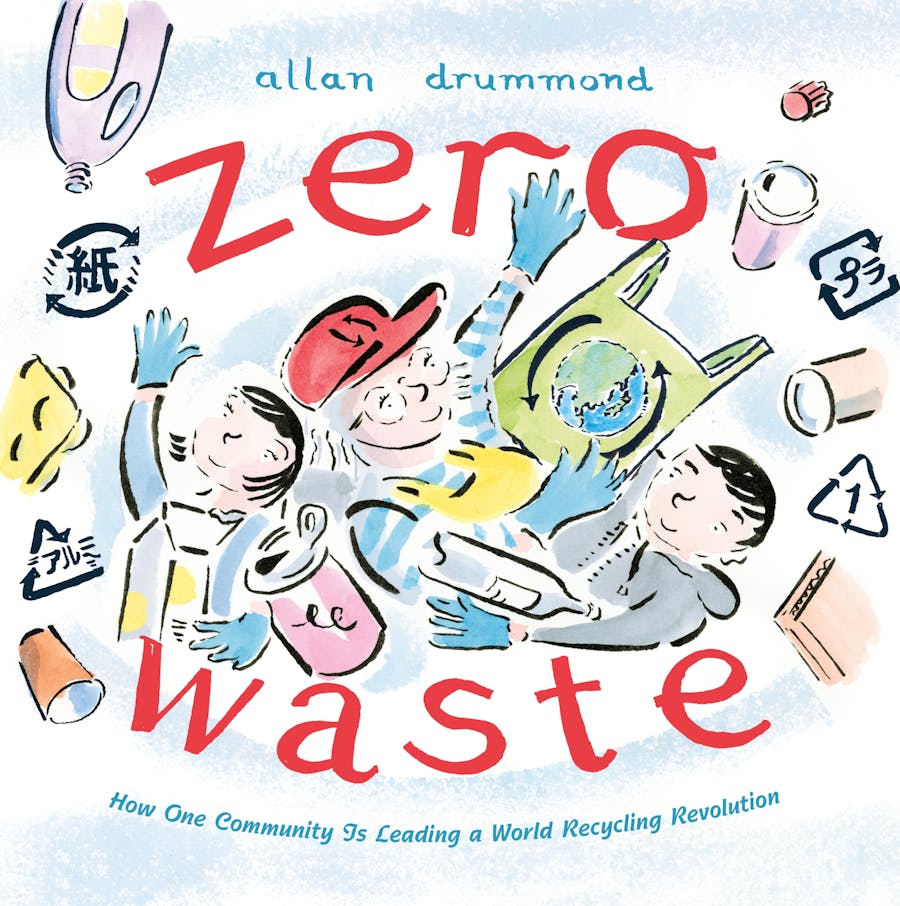 Zero Waste: How One Community is Leading a World Recycling Revolution
Zero Waste: How One Community is Leading a World Recycling Revolution
Written and Illustrated by Allan Drummond
Farrar Straus Giroux, 2023, 36 pp (unpaged)
ISBN: 9780374388409
This picturebook tells the journey of how an actual small village in Japan made and carried out their commitment to becoming a zero-waste community. It begins with two children visiting their energetic and wise grandmother who explains to them how and why the citizens of Kamikatsu increased their efforts to recycle, reuse what they have, and reduce the number of items they purchase to achieve zero waste. Kamikatsu, Japan, is now known worldwide for its sanitation innovations.
Told through illustrated and written text, the whimsical graphic style creates an element of fun, inviting readers to join the journey through the lens of one who might visit Kamikatsu. The opening end page visually welcomes readers to, “a small town… high up in the mountains… on an island… in Japan” providing readers with a feel for the geographic context where the story is situated. In a simple, yet sophisticated, manner the story includes thought and speech bubbles which give a conversational tone and represent different opinions, such as typical wonderings about how the community operates to achieve zero waste or a comment from someone who might doubt or question the work involved. Using Japanese proverbs, Grandma, a woman of few words but big action, teaches her grandchildren how to sort her trash for recycling. When they take the trash to the town recycling center, they learn that everyone in the town tries to recycle everything, which means sorting almost 50 different types of waste. There the journey shifts to Grandma telling the community’s struggles, which leads to Kamikatsu setting a goal and the collective work that gradually changes attitudes and practices over the span of twenty years.
Technology and human invention in daily life are depicted through the concept of zero-waste. In the small town of Kamikatsu, we see how wasteful behavior is unsustainable for the future. Everyone once deposited trash into “a great big hole” in the ground. Later, the filthy air and gasses produced by the town’s incinerators begins to destroy the beauty of the natural environment. It shows how individuals in the town worked to change the culture of thinking to achieve the goal of zero-waste. A new recycling center was built and is run by the Zero Waste Academy using the four L’s–local, low cost, low impact, and low tech–to guide its operations (Gray, 2019). We can learn from Kamikatsu’s example how humans might reduce, recycle, and reuse to solve problems and fulfill human needs.
Drummond conveys and reinforces the story’s message using sayings in the Japanese language. Grandma begins with kachou fuugetsu reminding children to, “Experience the beauty of nature. Learn about yourself.” Then she teaches them the importance of mottainai or “Waste not, want not.” Finally, in a message to encourage the world to join in the zero-waste trek, she uses the phrase chiritsumo or “A journey begins with the first step. Perseverance means power.” While they are introduced in Japanese which adds an authentic cultural layer to the story, the values that represent the words are universal and show connection through how they can be applied globally.
In Zero Waste, Drummond’s distinctive ink and watercolor illustrations are colorful, playful, and inviting. The book concludes with resources for further reading and a statement that the COVID-19 pandemic prevented him from traveling to Japan. He does not provide information about personal communication with individuals from Kamikatsu, thus, it might be implied that the sources listed were used as part of the research conducted to write the story. Pictures of Kamikatsu residents and of the recycling facility from Getty Images are presented on the author’s note page and since Kamikatsu has received worldwide notoriety, there are news stories (Lee & Inuma, 2022) and interview/presentations from sources, such as Akira Sakano, Deputy Chief Officer of Kamikatsu’s Zero Waste Academy, that are readily available online (Ted Talks, 2017) and support the accuracy of Drummond’s narrative.
Allan Drummond’s Green Power series highlights everyday communities. These stories-–Energy Island (2011), Green City (2016), Pedal Power (2017), and Solar Story (2020)–make a wonderful text set for students to learn about different communities and how they have taken steps to make a difference and live more sustainably. Another book that might inspire children to act is Old Enough to Save the Planet, (Loll Kirby & Adelina Lirius, 2021) a nonfiction picturebook about children around the world who made positive impacts in their communities to help save the planet.
Noted for his work as a children’s book author/illustrator, award-winning Allan Drummond is listed as a Suffolk artist who has also lived in Savannah, Georgia. His website features his work as a children’s author/illustrator.
References
Gray, A. (2019, Oct. 13). A Japanese Village that Went Almost Waste Free. CommonWealth Magazine. https://english.cw.com.tw/article/article.action?id=2564
Lee, M. & Inuma, J. M. (2022, April 27). Postcards from Kamikatsu, Japan’s ‘Zero Waste’ Town. The Washington Post. https://www.washingtonpost.com/climate-solutions/interactive/2022/japan-zero-carbon-village-climate/
Ted Talks. (2017, Feb. 21). Zero Waste: A way to enrich your life and the society/Akira Sakano/TEDxAPU. YouTube. https://www.youtube.com/watch?v=pgRnAsK18es
Michele Ebersole, University of Hawai’i
© 2024 by Michele Ebersole

WOW Review, Volume XVI, Issue 4 by Worlds of Words is licensed under a Creative Commons Attribution-NonCommercial-ShareAlike 4.0 International License. Based on work by Michele Ebersole at https://wowlit.org/on-line-publications/review/xvi-4/10/
WOW review: reading across cultures
ISSN 2577-0527
